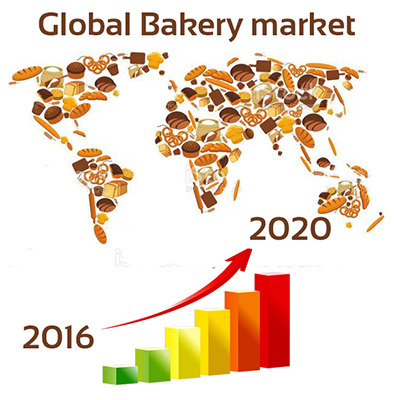Technavio analysts forecast the global bakery market to grow at a CAGR of more than 6% during the forecast period, according to their latest report.
The research study covers the present scenario and growth prospects of the global bakery market for 2016-2020. The report segments the market into the following four categories which are breads and rolls, cakes and pastries, cookies and others. The report also presents the competitor landscape and brand offerings of the key retailers.

According to Manjunath Reddy, a lead analyst at Technavio for food research, The numerous health benefits of gluten-free bakery products have increased their popularity in the Americas and Europe. Vendors have gradually begun to split their focus on health and indulgence cakes and pastries in Western Europe and north America. High-fiber bakery products are witnessing robust retail sales in Latin America and Asia-Pacific (APAC).
Technavio food and beverage analysts highlight the following three factors that are contributing to the growth of the global bakery market:
– Rising consumption of cakes and pastries
– Increasing popularity of functional ingredients in bakery market
– Rise in in-store supermarket bakeries
Rising consumption of cakes and pastries
There is high demand for cakes as a result of an increase in indulgent consumption. The demand for on-the-go snacks is also contributing to the demand for cakes and pastries. The sales of chocolatebased cakes increased by 19% between 2007 and 2012. Consumption of these products is usually unaffected by the prevailing economic conditions. Premium varieties in unique flavors are also much in demand and drive the snacks and pastries market. This is further supported by innovation in packaging, enabling easier on-the-go consumption.
Despite growing health consciousness, there exists a steady market for premium, indulgent foods — cakes and pastries being the prominent ones. Vendors have begun to split their focus on health and indulgence gradually in Western Europe and north America. This trend is now emerging in Latin America and APAC, where high-fiber bakery products have seen robust retail sales.
Increasing popularity of functional ingredients in bakery market Due to the increasing demand for bakery products suited for specific dietary needs, such as gluten-free, innovation becomes an important driver. functional ingredients are being used to enhance the products and make them healthier. Increasing innovation is apparent in the Canadian bakery market. Products containing flours other than wheat (rice flour and chia flour) have been launched in recent years. Out of the new products launched in Canada in 2014, an increasing number of bakery products claimed to have rice flour. Cakes and pastries and sweet goods constituted around 13% of these products.
Numerous products have been launched over the past couple of years, most of them with claims of being kosher or organic. Organic bakery products have also gained in popularity. The organic claim was the most common one within the bakery industry for products including cakes, pastries, sweet goods, sweet biscuits, and cookies.
Rise in in-store supermarket bakeries
In-store bakeries are found in grocery stores and are relatively small but offer a substantial range of fresh baked products, with increasing amounts of wholegrain bread being produced. Artisanal and industrial bakeries have had to contend with rising competition from the growing number of in-store supermarket bakeries that have their own offerings with competitive pricing. in-store bakeries are gaining prominence due to their lower prices and the convenience of one-stop shopping. Value-conscious customers are increasingly opting for private-label offerings of supermarkets.
In recent years, the parbaked or pre-baked or bakeoff range of products are increasingly making a mark. Par-baking is a two-stepped baking procedure, where the batter is baked partially for 15-20 minutes and in the next step, par-baked cakes are cooled and refrigerated until final baking. Many supermarkets, quick-service restaurants, and doughnut chains use pre-baking for bread and doughnuts because it is cost-effective, reducing the requirement for trained bakers. Prebaked bread and doughnuts are also used when there is a concern that quality cannot be maintained from site to site.
“Par bakery items are frozen to increase their shelf life and lower temperature also retains the texture of crumbs and reduces the rate of crumb hardening that results from staling. These cakes also provide an easy and fast way to offer consumers fresh bread and rolls,” says Manjunath.












